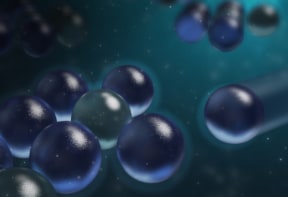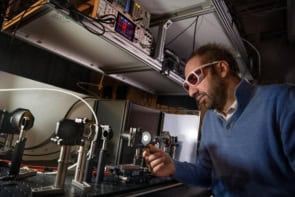
Ultrashort pulses of light can dramatically alter the electronic and magnetic properties of certain materials. Indeed, such pulses have already been used to modify band gaps in graphene and topological insulators. The main drawback is that the laser light employed is extremely intense, making it easy to damage the materials through excessive heating. Researchers at the California Institute of Technology (Caltech) have now developed a new method that does away with this problem. Their approach could aid the development of ultrafast light-based computers and even make it possible to create materials such as exotic quantum magnets that are difficult or impossible to produce naturally.
The Caltech method relies on a technique known as Floquet engineering in which the properties of a quantum system are modulated by means of an applied field, such as a light field, over very short timescales. This technique requires strong driving (or “pumping”) electric fields characterized by the so-called Floquet parameter E ≡ eaEpu/ ħΩ, where e is the charge on the electron, a is the material’s atomic spacing, Epu is the pumping field, ħ is the reduced Planck’s constant and Ω is the driving frequency. For a typical solid with a ≈ 3 Å, the field required is around 109 V m−1 at optical or near-infrared frequencies – more than enough to heat up the material.
To get around the problem of laser heating, a team led by David Hsieh chose a magnetic insulator, manganese phosphor trisulphide (MnPS3), that naturally absorbs only a small amount of light over a wide range of frequencies in the infrared part of the electromagnetic spectrum. They then fine-tuned the frequency of the laser light so that it changed the material’s electronic properties without imparting any heat to it.
Coherent optical engineering
In their work, Hsieh and colleagues used intense infrared laser light pulses, each lasting around 10-13 seconds, to rapidly change the energy of the electrons in their sample. In the process, the five-fold degenerate 3d orbitals in the manganese split into a low-energy t2g triplet and a high-energy eg doublet. This rearrangement causes the material to change from a highly opaque state to a highly transparent one. Importantly, the change is reversible: once the laser beam is switched off, the material spontaneously reverts to its original state without suffering any damage to its electronic structure.

New Floquet maser is very good at detecting low frequency magnetic fields
The team note that this spontaneous reversion would not be possible if the material had absorbed the laser light and heated up. They explain that the method, which they term “coherent optical engineering”, works because the laser light alters the difference between the energy band gaps of electrons in the MnPS3 without “kicking” the electrons into different energy levels – the process that generates heat.
“It’s as if you have a boat, and then a big wave comes along and vigorously rocks the boat up and down without causing any of the passengers to fall down,” Hsieh explains. “Our laser is vigorously rocking the energy levels of the material, and that alters the materials’ properties, but the electrons stay put.”
The technique, which is detailed in Nature, could be used to create artificial materials such as exotic quantum magnets using light, Hsieh adds.



